On Friday night RB Leipzig travelled to Hoffenheim, winning 2-0, and in doing so, with the title looking all but wrapped up by Bayern Munich, they took one step closer to at least clinching a Champions League place as the Bundesliga season nears its finish. It was an open game where Hoffenheim started the fastest of the two sides, spurring a couple of excellent chances as well as having a penalty overturned with the score at 0-0 for a handball in the build-up. It could have been so very different.
The penalty decision seemed to rock Hoffenheim and kick the visitors into gear and Leipzig played some truly electric football at times, most notably in the first half, and went into the break two goals to the good.
They were unable to build on their lead in the second half, and there seemed to be a theme running through the game of sloppy finishing.
This tactical analysis will give an analysis of the tactics used in this game.
Lineups, formations and notes
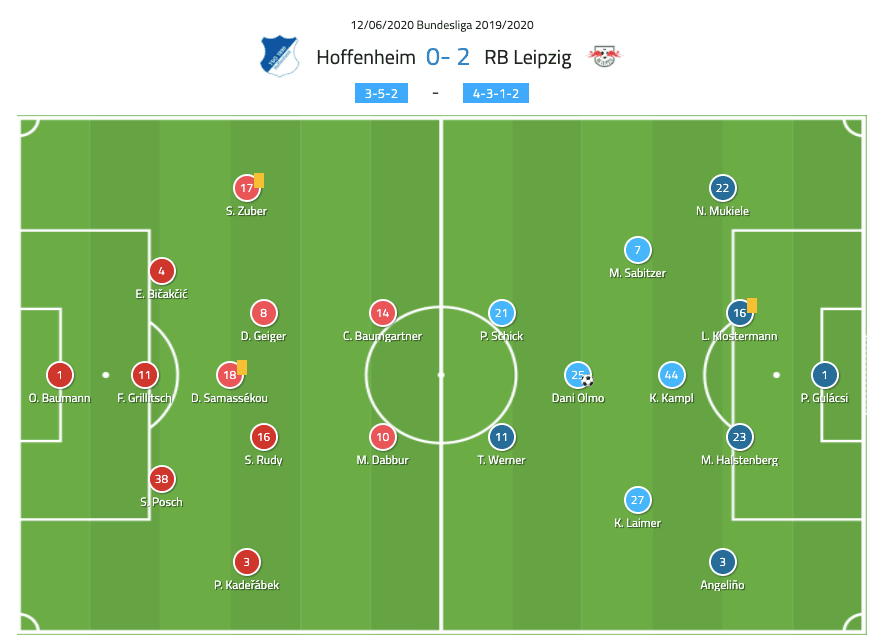
Hoffenheim had to reshuffle due to Benjamin Hübner’s sending off in the previous game. They opted to play with a 3-5-2 with Florian Grillitsch flanked by Stefan Posch and Ermin Bičakčić either side of him as part of a back three. However, he was given a fair bit of freedom to roam forward in attack and was really used in the back three as the player to launch attacks for Hoffenheim, making long passes to either flank to switch play to the left and right wing-backs Steven Zuber and Pavel Kadeřábek.
Moanes Dabbur was played as the furthest forward striker, despite the above formation, with Christoph Baumgartner playing alongside him but having the freedom to drop into midfield more or shift across the width of the pitch. Dennis Geiger seemed to struggle to influence the game in this role, and with Diadie Samassekou being brought off at half-time and Sebastian Rudy struggling to have an impact on the game himself, it perhaps would have been more pertinent to take advantage of Geiger’s abilities as a ball progressor from a deeper role. Hoffenheim struggled to deal with Leipzig attacking centrally and didn’t create a great deal of attacks themselves from this area either. Marcel Rapp will want to look at this area in the final stages of the season.
We continued to see Hoffenheim’s struggles, started of course by Alfred Schreuder playing players in a variety of positions, perhaps not in their favoured position. Over the course of the game, we saw the hosts play three different players in the left wing-back role: Zuber, Robert Skov, and Ihlas Bebou. They structured a significant amount of their attacks down the flanks, specifically on the left-side, but there was a lack of quality in delivery from this side in the first-half which definitely prompted Skov’s arrival at the break. The image below shows their offensive duels over the course of the game, and shows a good deal of unsuccessful duels (white squares) on the left-flank.
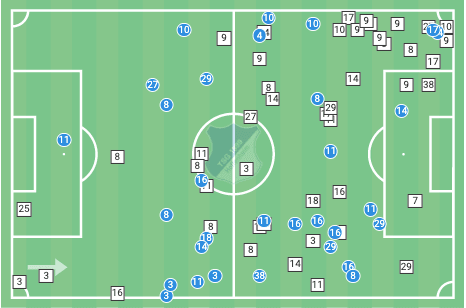
Admittedly, Hoffenheim were far more attacking then they had been under Schreuder, where they averaged under 12 shots per game. In this game, they had 23 shots. But other than this it was a fair representation of their season. A good share of possession, looking to stretch the pitch horizontally to aid vertical possession, and an overall feeling of imbalance in this side, regardless of the talented individuals dotted throughout. However, with the former Head Coach’s reign coming to an end over a difference in how Hoffenheim were to move forward, it’s fair to assume there will be little money to spend this summer and the next incumbent will have to continue looking to fit square pegs in round holes, or maybe, just maybe, choose a system that fits this side better than the one they currently use.
Leipzig went with a 4-3-1-2, using Dani Olmo in the space behind Patrik Schick and Timo Werner to perfection to carve open the Hoffenheim defence consistently between them. They looked weak at the back, with injuries and suspensions meaning Lukas Klostermann and Marcel Halstenberg were at centre-back, whilst Nordi Mukiele and Angeliño were on either side of them. I will go on to detail the weaknesses of this back four unit as well as the attacking potency of Olmo, Schick, and Werner later on.
Behind Olmo in midfield they operated with an incredibly solid trio of ball-winning and ball-progressing midfielders in Marcel Sabitzer, Kevin Kampl, and Konrad Laimer.
Hoffenheim exploiting space between Leipzig’s defence
In the introduction, I mentioned the great number of shots Hoffenheim took, as well as their superior xG to Leipzig’s. A glance at their shot map, and despite some speculative efforts from outside the box, we can see the bulk of their shots were from inside the 18-yard-box, albeit not too close to goal, with only one coming from inside the six-yard box. Of their 23 shots, only three had an xG higher than 0.2 but nevertheless they registered a 2.08 xG for the game, higher than Leipzig’s 1.31 xG.
It’s worth pointing out that Leipzig had the same amount of shots on target but from 11 fewer efforts. There is definitely work to do in the finishing department for whoever takes the Hoffenheim job permanently. But credit should go to Rapp for at least making a short term impact on shots taken, particularly against a side as strong as Leipzig.
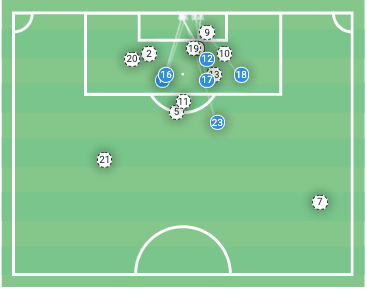
They gained most of their early success, where they were most dangerous, in managing to capitalise on a Leipzig defence that was slow to react to the transition. There were several occasions where Leipzig lost possession and their defence remained spread wide for too long and Hoffenheim’s attackers, Dabbur and Baumgartner, were able to run into the gaps and receive the quick forward pass over the top or through the gap itself, to run onto.
Below we can see Leipzig’s back three is spread wide, with the two Hoffenheim attackers still relatively high as Leipzig lose possession in midfield.
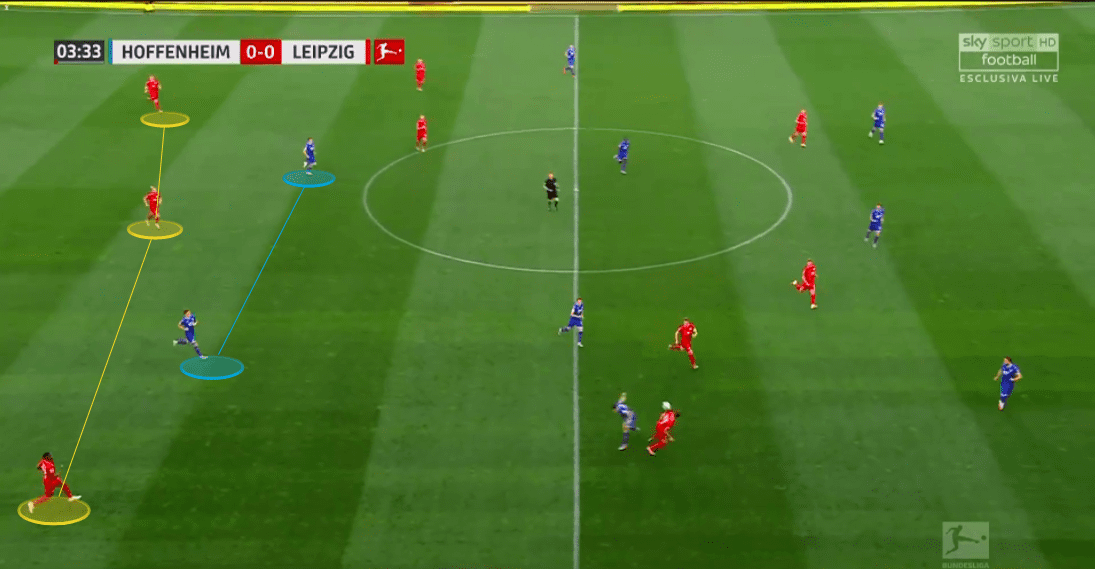
After winning back the ball, Geiger is able to quickly find the pass over the top and we can see how, despite Mukiele tucking in, there is too much space between the centre-backs.
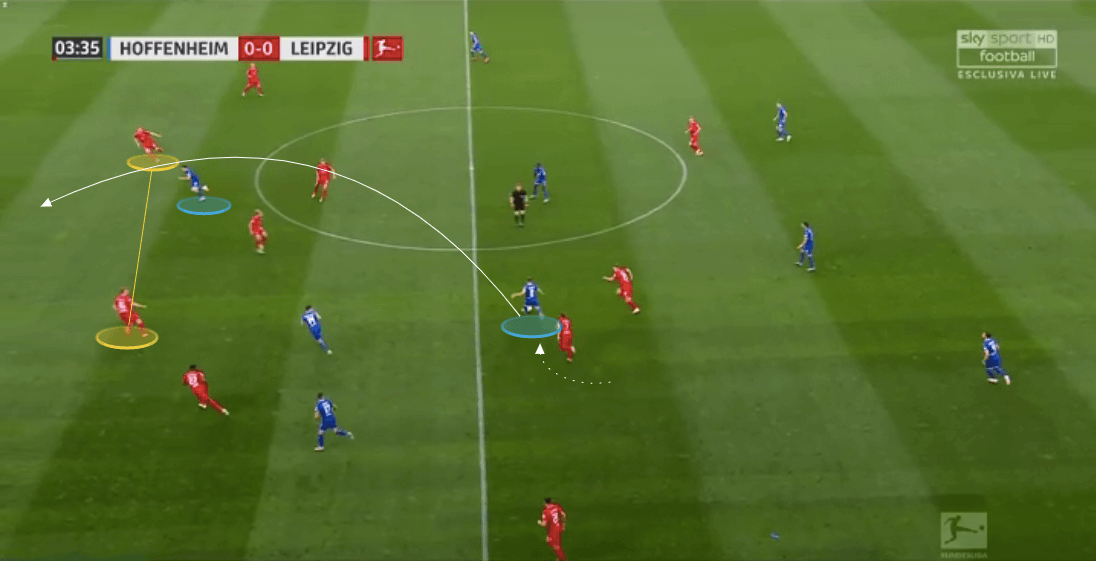
Even after the overturned penalty and Leipzig’s two goals, Hoffenheim still were able to find chances from hitting the space between Leipzig’s centre-backs.
Angeliño has been an excellent pick-up for Leipzig but is undoubtedly stronger going forward than he is defensively, and below was an example at how Angeliño was being easily bypassed which dragged Halstenberg into a wide area he didn’t want to be in, and leaving space once again between himself and Klostermann.
A cooler head in this situation and Hoffenheim would have got one back so quickly after going two down, and could well have clawed their way back into this game.
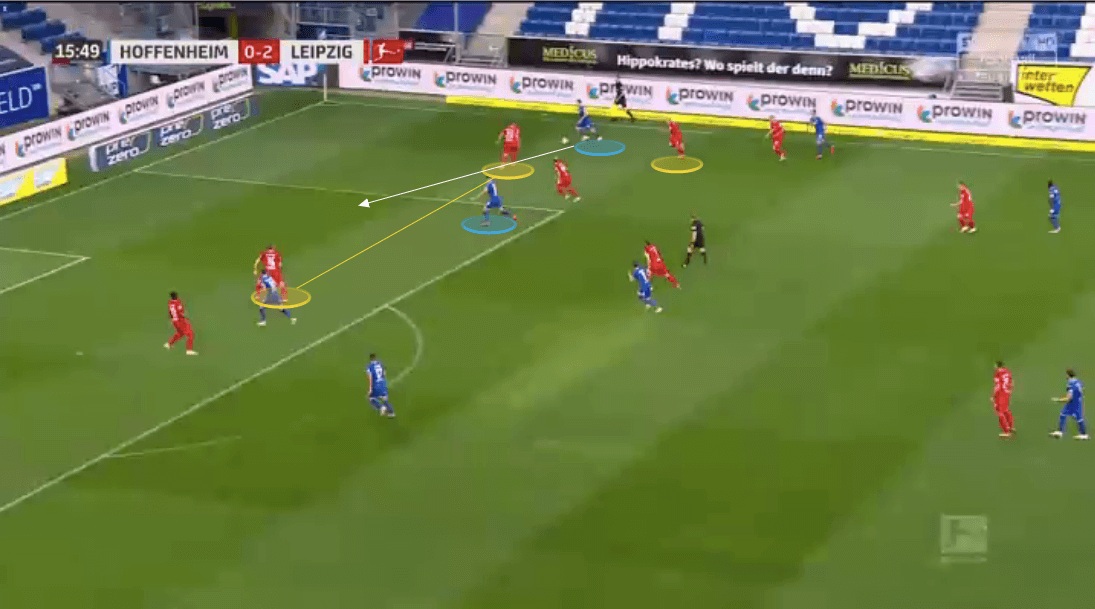
Focusing their press on Mukiele
Hoffenheim and Leipzig pressed with intensity throughout the game with both registering average PPDA’s of under eight. Along with the general openness, and perhaps sloppy possession play at times too, the intense pressing from both teams led to plenty of overturned possessions in good areas for the opposition to counter from.
Leipzig were very direct as soon as they won the ball back and would use Werner’s pace in behind to quickly turn the attacking transition into a dangerous opportunity – if only Werner had had a better day in front of goal.
Hoffenheim seemed to focus their press on Leipzig’s right-back Mukiele. I was initially surprised by this. Mukiele is an all-round talent and not someone I have noticed as an obvious target for a team to press, but nevertheless Hoffenheim sought to do this, and in the first half in particular, pressured Mukiele into making many a mistake, which could have proven costly. They put him under pressure as soon as he received possession and looked to cut off any passing options, before intercepting his wayward passes. Hoffenheim’s press made a total of 15 recoveries in the Leipzig defensive third.
The image below shows all of Hoffenheim’s interceptions from the game and there is a good cluster coming from high positions in the right-back area. Five of the six interceptions they made here came from Mukiele’s passing.
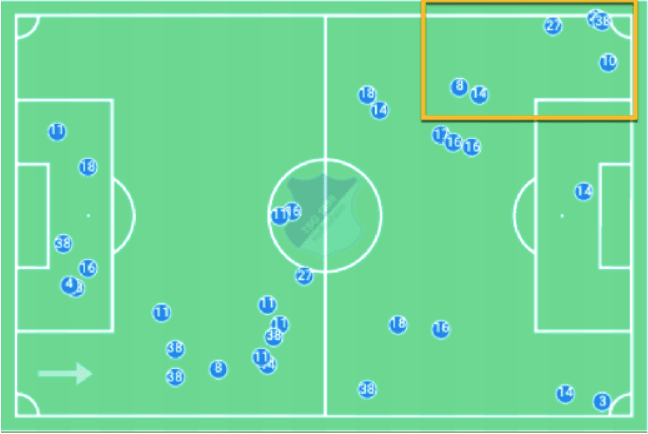
Both Baumgartner and Dabbur were quick to press the back centre-backs and deepest pivot of Leipzig, with the visitors resisting the temptation to play long and instead looking to play out using the space left on the flanks.
This was left intentionally by Hoffenheim. We can see in the image below how even Baumgartner’s pressure of the ball-carrier Klostermann is angled to encourage the centre-back to play to Mukiele.
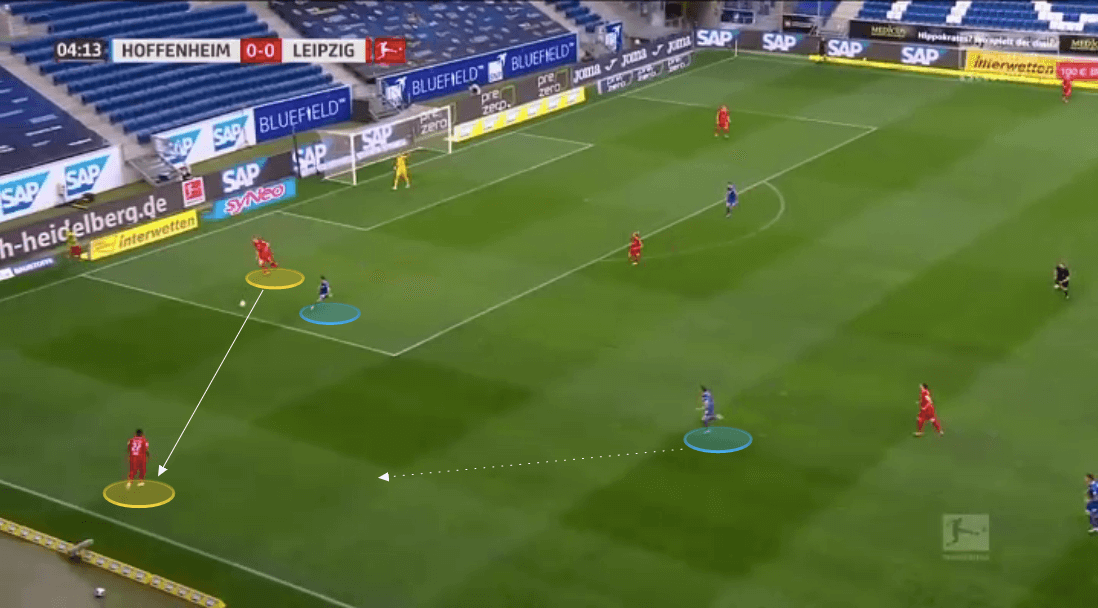
As soon as Mukiele received possession Hoffenheim sought to block any lateral or backwards passing options, as I have shown with the red arrows, and marked any forward passing options tightly too. In this instance, Mukiele’s only safe option was to play long. However, the right-back chose not to do this.
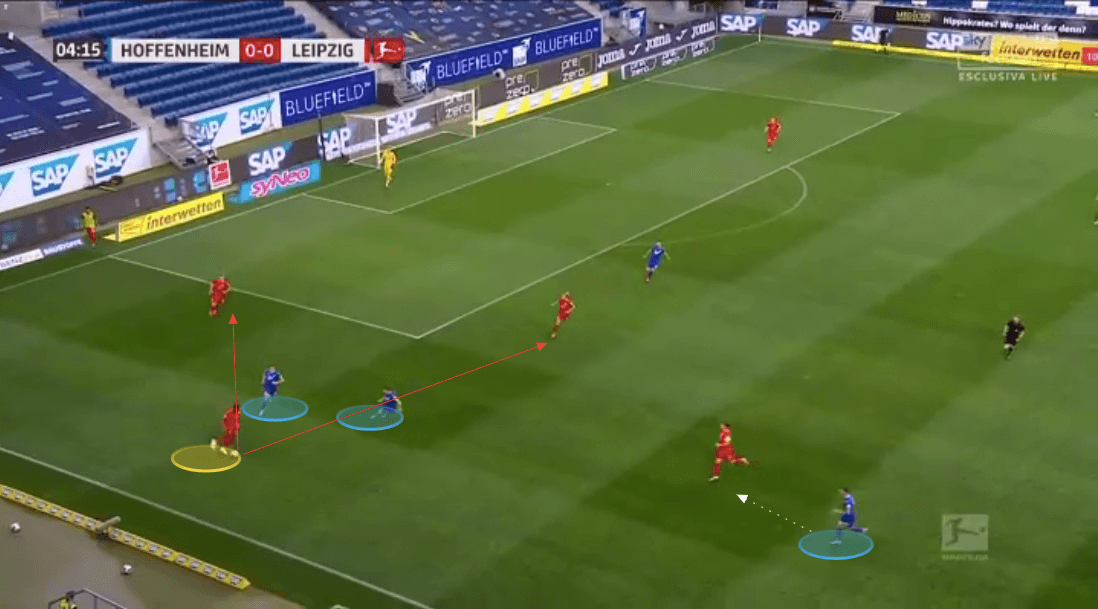
He instead looked to force the pass inside. Not a terrible idea, knowing that the trio of Olmo, Schick, and Werner would be looking to drop into this area and receive passes from wider angles here. But Hoffenheim were clearly prepared for this.
Samassekou was positioned specifically to thwart this and as soon as he received possession in this example, we can instantly see how once again the Leipzig centre-backs were vulnerable on defensive transition due to the width between them, and Dabbur had space to receive between the two.
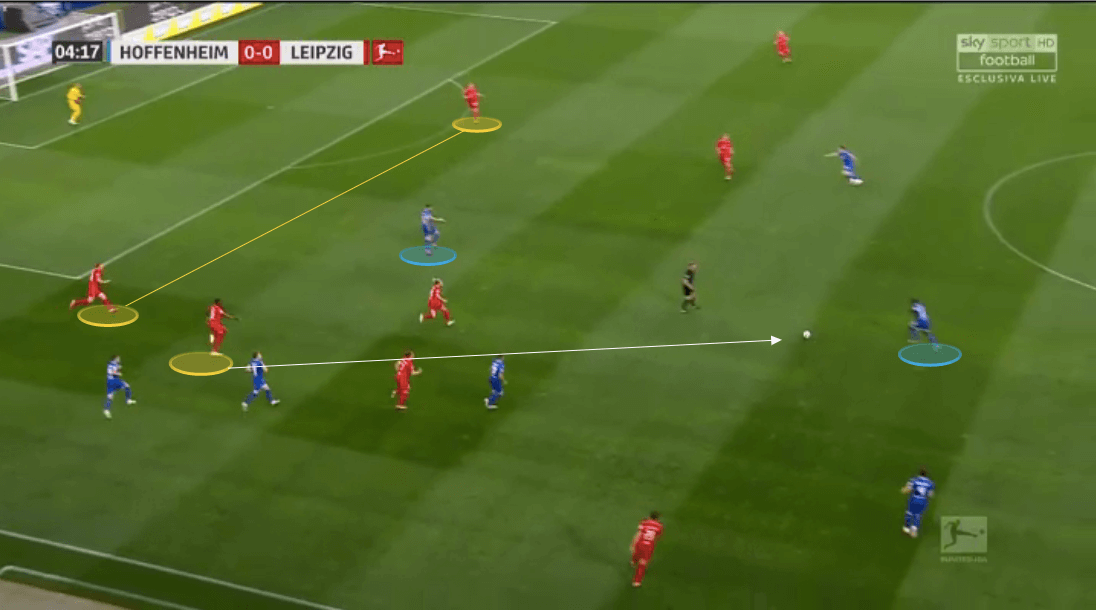
Hoffenheim did well to prevent Leipzig playing out easily and initially had them under sustained pressure, continuously forcing errors as the visitors tried playing out and beating the press. It was this sustained pressure that led to Hoffenheim earning that penalty just 40 seconds after the moment shown above.
Leipzig’s front three
Olmo has shown in his short time with Leipzig already that it would be a sensible prediction to say that, along with Nkunku, Leipzig might have one of the most exciting attacking midfielder duos in European football next season. With Werner leaving, there will be pressure on these two to fill the void left by the forward’s move to Chelsea.
Olmo was outstanding in the first half of this game and was a big reason why Hoffenheim looked so vulnerable through the central channel throughout. The image below shows that Leipzig’s best chances from positional attacks came from this area – a rather worrying indictment of Hoffenheim’s 3-5-2, perhaps.
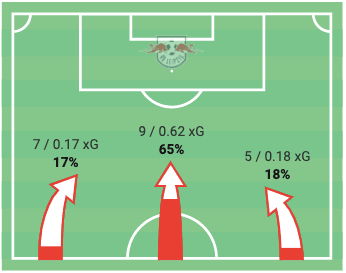
Olmo operated just shy of his front two and constantly in between the lines. He was able to receive passes which drew Hoffenheim’s defenders forward, leaving their back three unbalanced, and with Werner operating on the last man, they were able to release him on occasion into space with room to run. On another day, Werner might have had a hat-trick.
Below we see a quick interchange between Laimer and Olmo, as Olmo draws Posch towards him before playing Laimer back in, who himself draws Grillitsch forwards too.
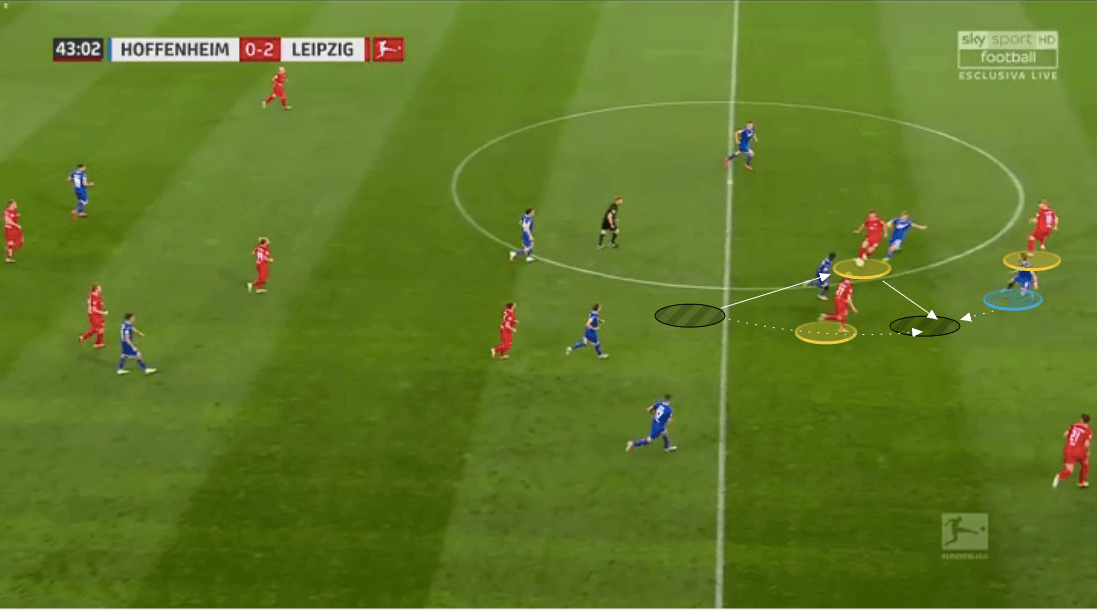
Werner is able to curve his run to stay onside and Laimer threads the ball through to the forward.
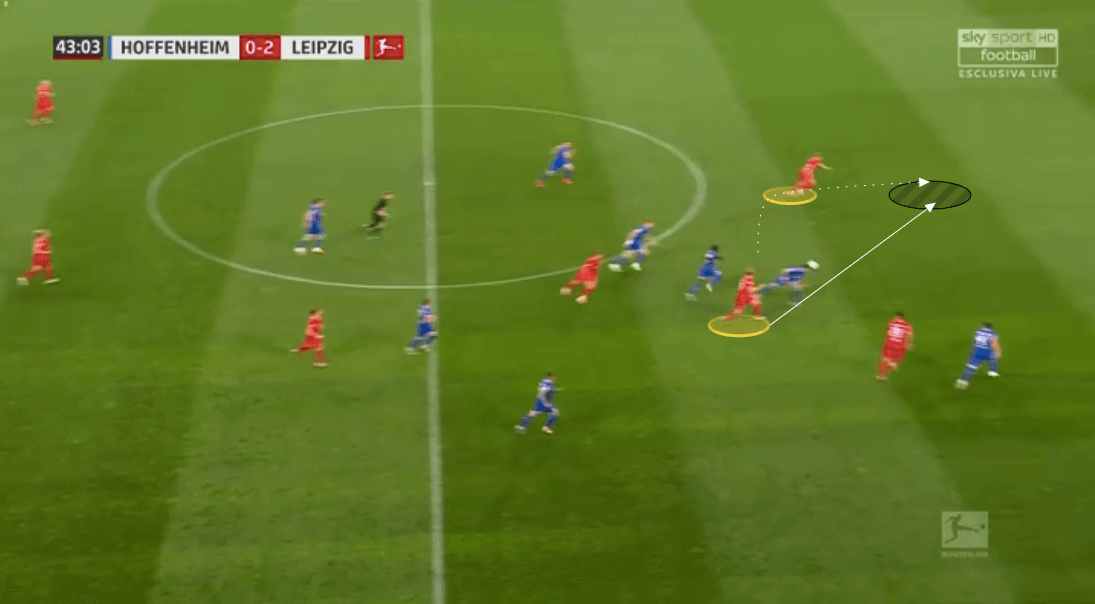
It wasn’t just Olmo operating in this space and Schick proved once again that he’s a versatile “target man” who plays with an excellent reading of the game.
He frequently dropped in himself, and Olmo reacted by pushing up to join Werner and ensure Hoffenheim’s back three had to stay where they were and not follow Schick forwards. If Olmo stayed in his space, Hoffenheim could have committed a defender to mark Schick leaving a two-on-one against Werner, however, with Olmo pushing up they kept all three back to ensure they had numerical superiority but sacrificed possession in between the lines as Schick could receive and turn.
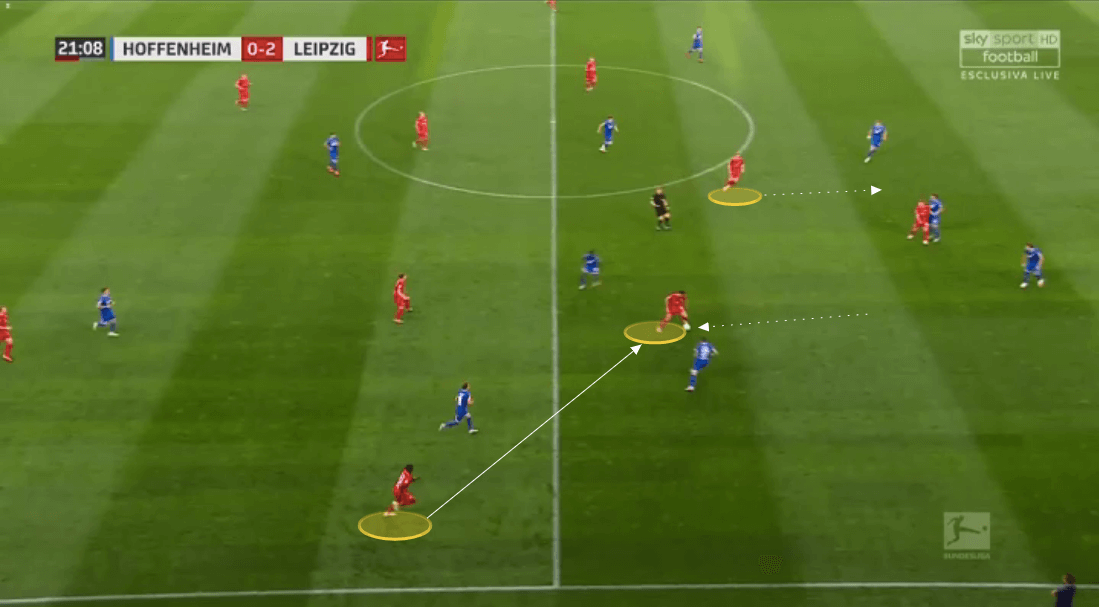
This pattern continued in the second half and Rapp didn’t adjust to it, choosing not to drop a midfielder to operate in between the lines with more discipline than Samassekou had in the first half.
Below Schick drops in once more leaving Olmo and Werner as the two forwards. Posch pushes up to pick up the target man, leaving Werner and Angeliño in an overload on the Hoffenheim right wing-back.
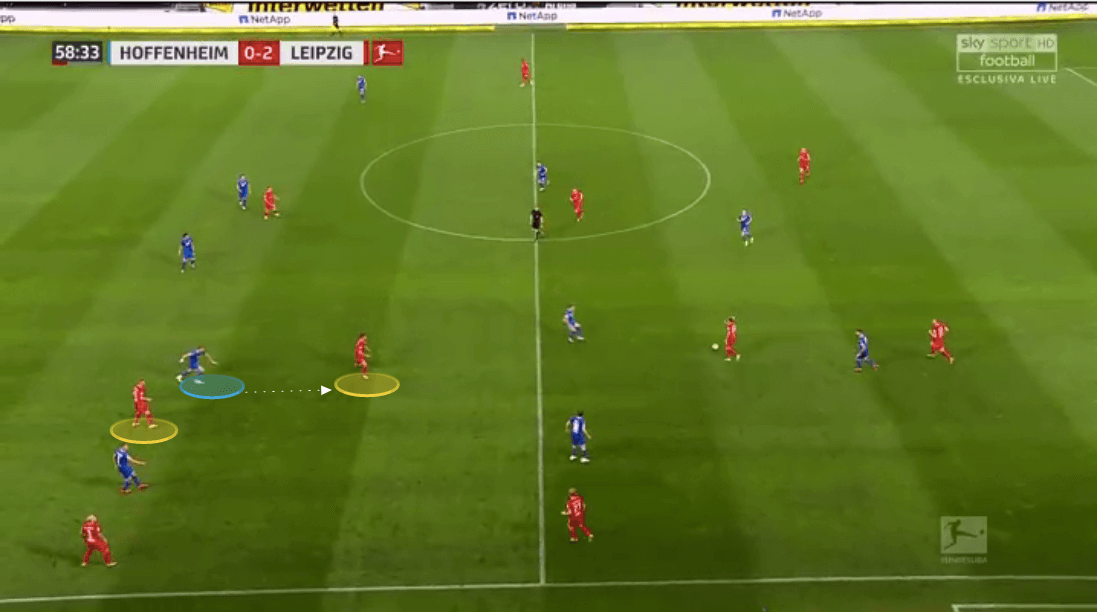
Leipzig were clearly looking to achieve this and instantly worked the ball wide, where there was the angle to play Werner through in the huge gap the forward found himself in.
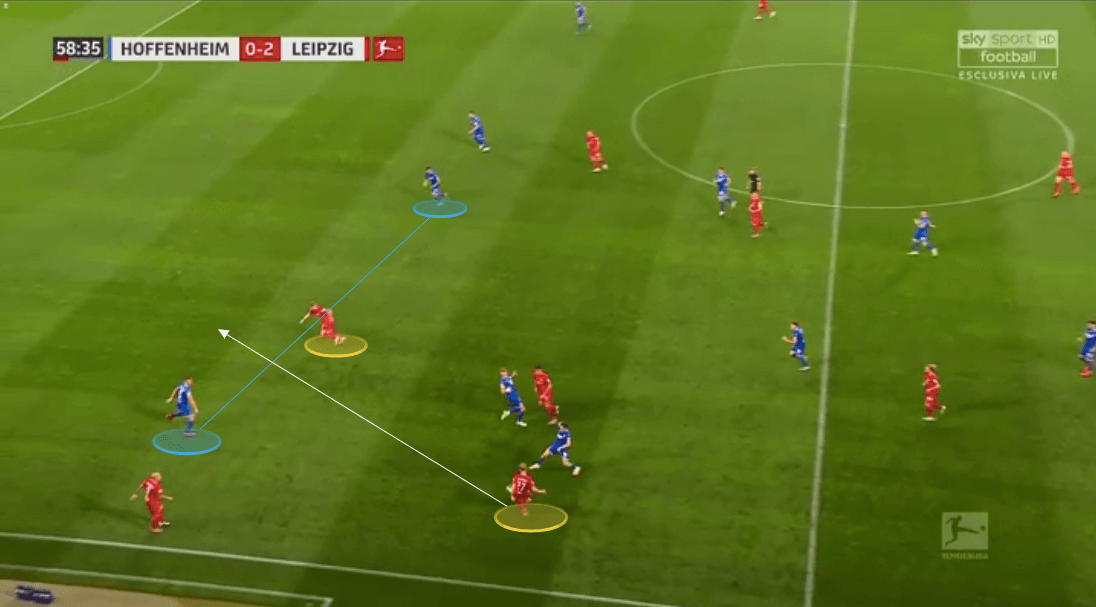
Albeit not part of the front three this section is focusing on, Angeliño has been a very astute pick-up by Leipzig this season and his relationship with Werner has flourished.
Leipzig’s pass map shows how important that link is between the left-back and the centre-forward with plenty of play between the two over the course of the game.
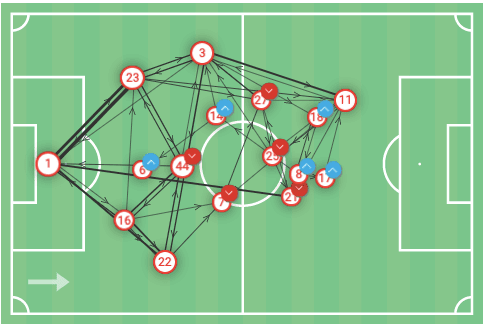
We saw Leipzig using the same build-up patterns we see from them in their 3-5-2 with Kampl or Laimer predominantly dropping between Klostermann and Halstenberg in the build-up to allow them to build with a back three and most importantly allow the full-backs to push forward and play as wing-backs.
Angeliño’s movement below was key in allowing Werner to get in possession early rather than just play on the last man. Werner is so much more than this as a forward and is an excellent ball progressor himself if he can receive the ball in these areas and have space to turn and drive forward into the opposition half and take on players. As Angeliño pushes forward, he creates the space for Werner to come into this area. Should Posch have followed him, it would have created an easy angle for Angeliño to cut behind the Hoffenheim defence to latch onto a through ball from Werner, so getting possession in these areas was a win-win situation for Leipzig.
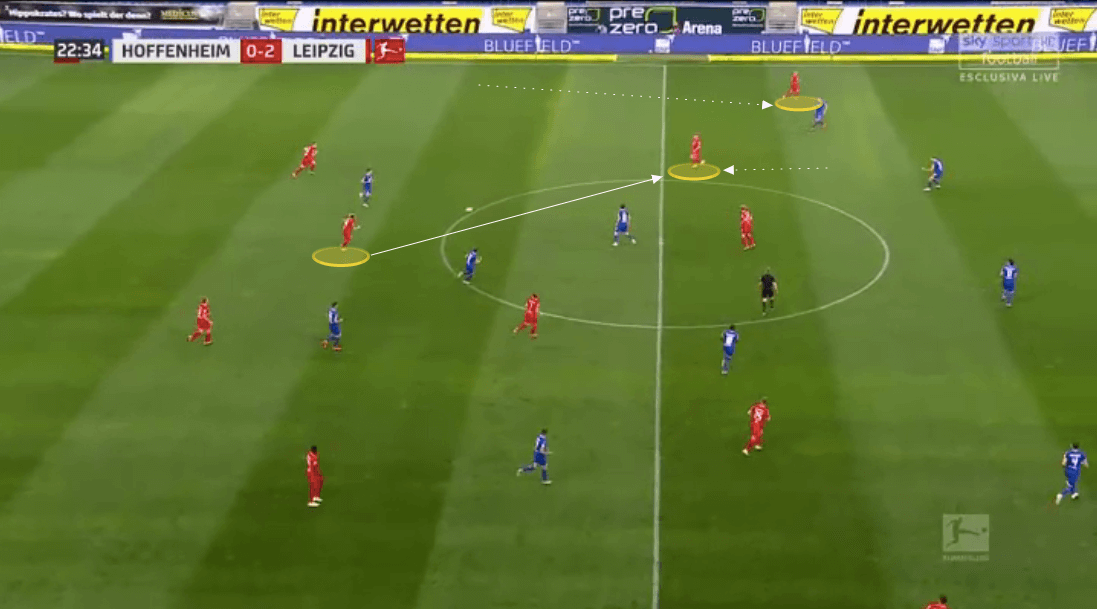
Conclusion
Leipzig maintain their unbeaten run since the restart, and due to superior goal difference are just a win away from securing Champions League football.
It will be fascinating to see how this team adapts to Werner’s departure since he is so influential, however, there is more than enough talent in this squad to stop them from having to dip into the transfer market and look for a replacement. I would love to see Olmo and Nkunku play either side of Schick in and have Sabitzer in a slightly more advanced role in a 4-2-3-1, but that conversation is for another time and another article.
Hoffenheim have the parts to be a good side, and they’re really not far from being one. It seems unlikely they will address the obvious issues in the transfer market, and although there were some major improvements in this game, they still looked weak in front of goal and spineless in defence, suggesting Rapp has some way to go before convincing the board he should be anything other than an interim coach, should he want the permanent job.




Comments